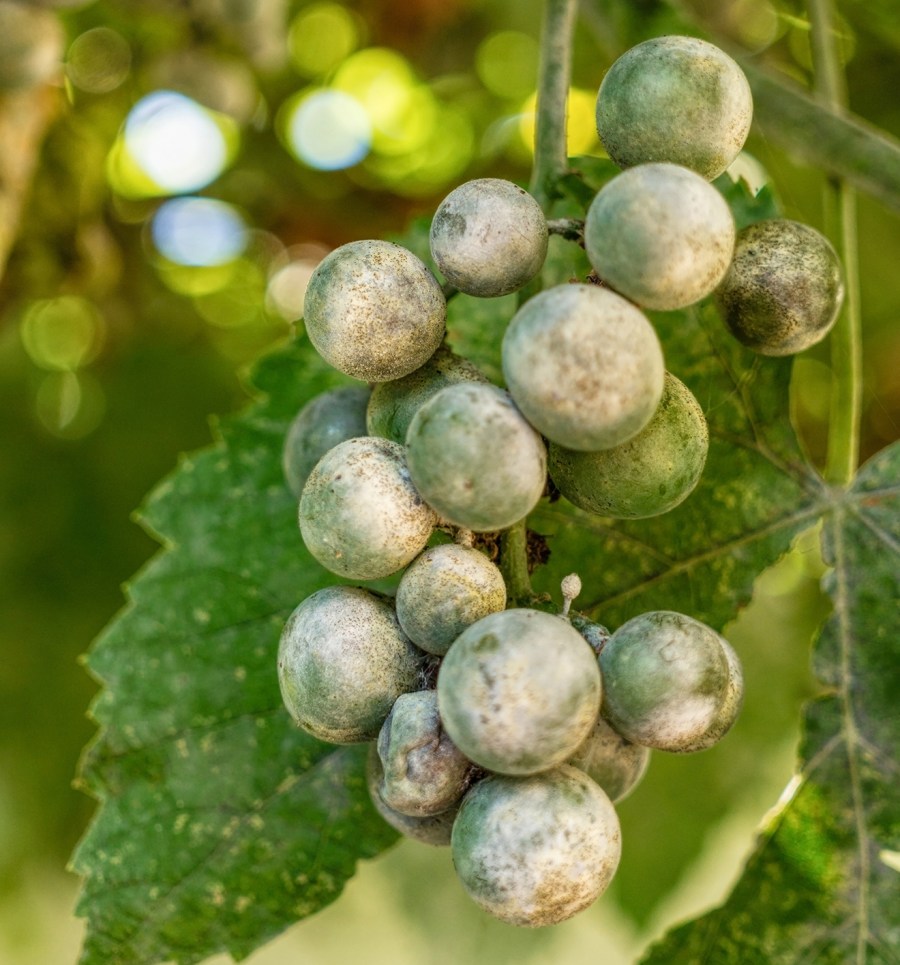The EU ban on mancozeb in 2021 marked another milestone in the drive to find more sustainable ways of managing disease in grapevines. Hutchinsons agronomists Rob Saunders and Chris Cooper look at a few early season options.
Protecting the fresh growth that bursts into life during April and May, is vital for ensuring diseases such as Phomopsis and downy mildew do not get an early foothold in vines.
Historically, two or three well-timed applications of mancozeb were often sufficient, however the focus is now on developing sustainable strategies that integrate chemical and cultural methods, plus other options that enhance natural plant defence mechanisms. Being proactive with a ‘little and often’ approach, rather than reactive with fungicides, is very much the way forward.
Manage canopies for Phomopsis
For Phomopsis control, ensuring good air movement around canopy, bunches and crown, can be very effective at reducing disease risk, while also helping to manage other diseases, such as powdery mildew, or Botrytis later in the season.
Avoiding excessive canopy growth is therefore crucial, and requires careful nitrogen management. Vines do not require large amounts of nitrogen, but it is an important nutrient for building strong canopies, especially when growth is rapid during the spring.
Tissue testing around flowering will be useful for determining crop requirements, and where additional nitrogen is needed, slow release foliar fertilisers can provide a useful top-up to a solid base level of soil nutrition, although should not be applied during flowering or grape set.
While soil-applied fertiliser remains important for building canopy, root uptake is inherently more reliant on moisture, potentially causing sudden spikes in availability, and resulting in surges of canopy growth.
Foliar fertilisers offer more predictable, efficient, plant uptake, and may be particularly useful for keeping vines going when soils are very dry. Indeed, if conditions turn dry again this season, they may be beneficial in any newly planted sites that struggled to get roots established in the very dry conditions witnessed last year, although growers cannot rely on foliar fertilisers alone for building large amounts of extension growth.
Many different foliar nitrogen fertilisers are available, including a new product called R-Leaf. It is made up of photocatalyst particles that remain on the leaf surface and convert atmospheric nitrogen oxide (NOx) pollutants, namely nitrous oxide, nitric oxide and nitrogen dioxide, into a nitrate form that can be taken up by the plant.
The green credentials sound promising, especially for growers looking to reduce their carbon footprint, however as a new product to the market, we need to see its performance in UK conditions before drawing firm conclusions.
Another useful option for Phomopsis and powdery mildew control is the milled sulphur product, Thiopron. A single application at woolly bud stage, also offers some protection against Erinose mite, but in high-risk crops, such as where high levels of mite were seen the previous year, two applications may be needed; one at early woolly bud and another at late woolly bud.
Mancozeb was one of just two active ingredients approved for Phomopsis control in grape vines, the other being kresoxim-methyl. The latter still has some activity against Phomopsis, although its greatest strength is against powdery mildew.
Downy mildew options
While good canopy management, strict vineyard hygiene, and other cultural techniques will help manage downy mildew risk, unlike Phomopsis, it can be more challenging to control with such methods alone.
A useful supporting measure is the targeted application of nutritional products that fortify the plant’s natural defence mechanisms, such as Procrop ISR, giving vines greater resilience to disease infection.
Such biostimulants are purely a protectant strategy though, so programmes need to start early in the season once there is sufficient green leaf area for uptake, and while disease risk is still low, with no visible signs of infection.
It is worth monitoring conditions to identify when downy mildew risk is likely to increase, using the 10-10-24 rule as a guide; 10mm of rain during a period when temperature is more than 10°C for 24 hours.
Once disease risk increases, it can be worth applying a good quality phosphite (e.g. Phorce) to further improve the robustness of plants to infection. Phosphites have been shown to stimulate production of antimicrobial compounds (phytoalexins), thereby enhancing the vine’s natural disease defence mechanism.
Deploying stimulants to promote resistance to disease is useful, but during severe disease pressure, or at sensitive growth stages like flowering, there is no substitute for fungicides based on actives such as metalaxyl-M, amisulbrom, ametoctradin + dimethomorph, cymoxanil or copper.
For more like this, sign up for the FREE Vineyard newsletter here and receive all the latest viticulture news, reviews and insight




